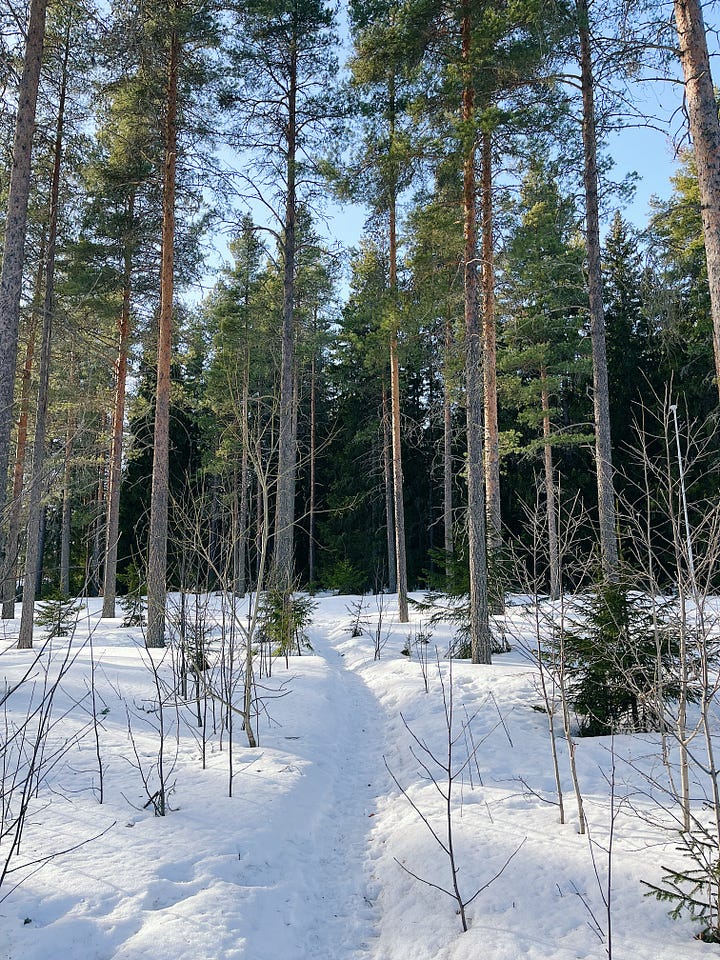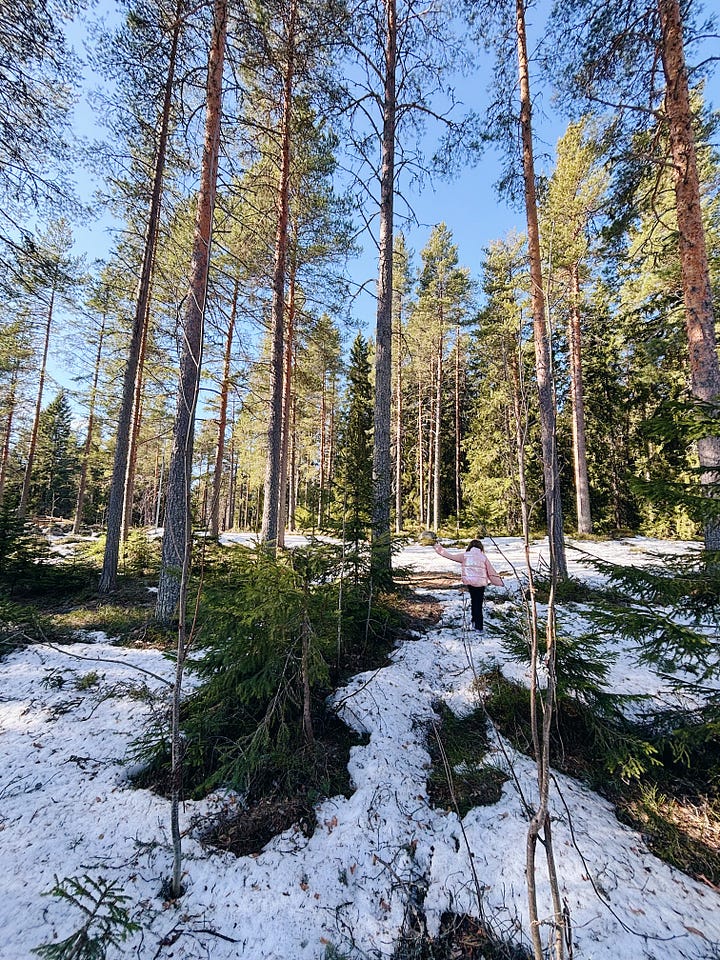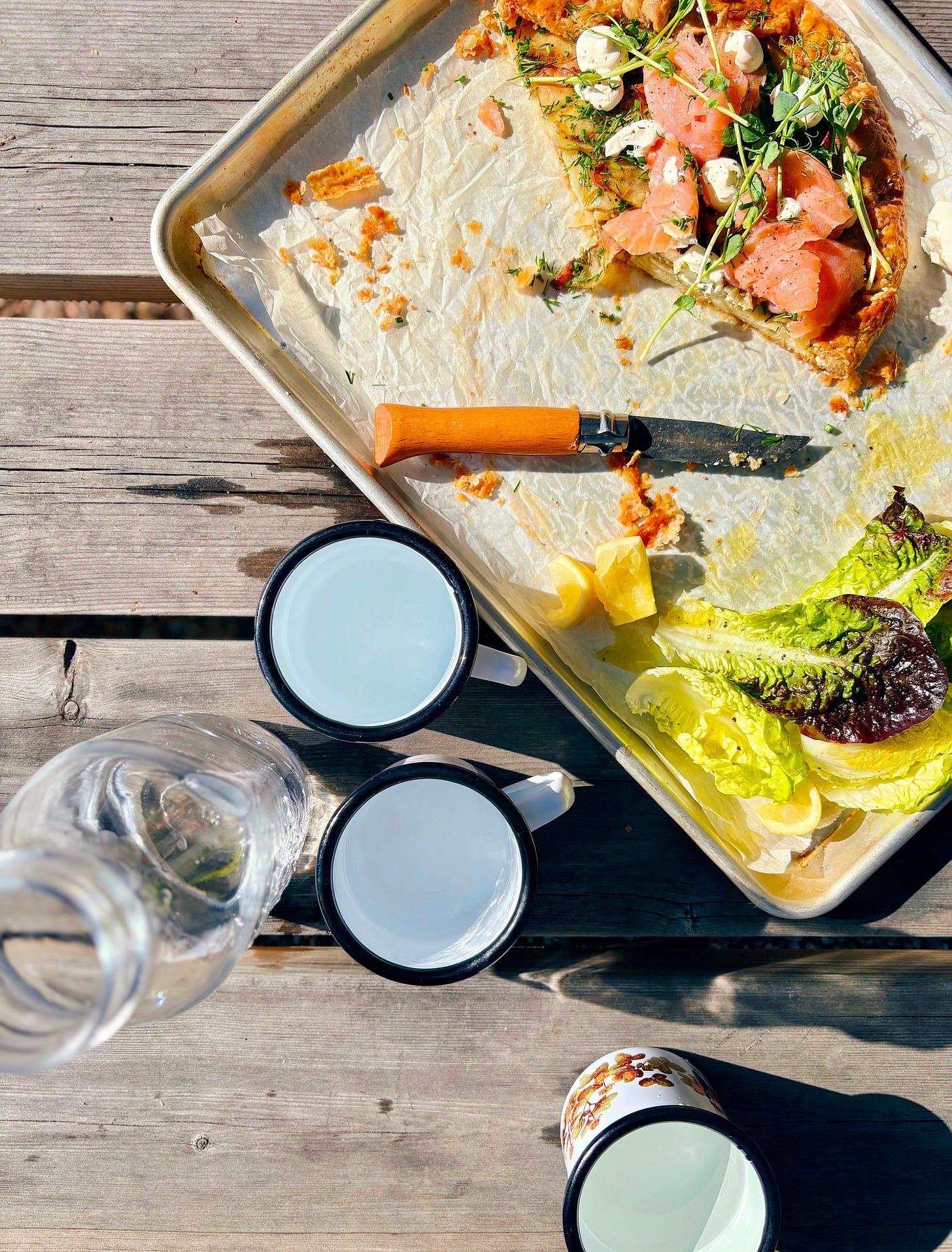Spring potato galette with smoked salmon
Flaky rye crust, mandelpotatis, horseradish, and a little green hope, shared outdoors.
Welcome to The Bakers’ Cottage – a newsletter about recipes, stories, and the quiet rhythm of baking in the north. If you’re new here, thank you for joining. And if you’re already a subscriber – I’m so glad to have you back.
If you enjoy what I write and want to support my work, please consider becoming a paid subscriber. It helps me spend more time developing recipes, writing, and keeping this space filled with good things.
This week’s post is about a galette we make every spring – flaky rye pastry, buttery potatoes, curls of smoked salmon, a spoonful of crème fraîche, and the first bright green shoots from our windowsill garden.
But really, it starts earlier than that.
With a walk along the skogsstig [forest path] behind the house. A handful of yellow peas pressed into cold soil. A terracotta dish in our kitchen, misted and covered, waiting. Watching the daffodils we planted last year – after Easter – begin to push up by the edge of the forest.
And then – a lunch in the sun. At last.
The full recipe is just below, along with notes on the pastry, the potatoes, and what to serve on the side.
It started before Sienna was born, but only grew stronger since – this habit I have of comparing days, year after year. Same date, same place, different light. I check how many berries – like red candies in the yellowing leaves – the rönn [rowan tree] carry in autumn. When the first snow falls, and if it lasts on the ground or melt into dew. How early the tulips begin to push through. When the first summer rain arrives, leaving behind dimma [mist] and the scent of wet blueberry and lingonberry bushes, and pine needles. You get it.
It’s become one of my quiet rituals – not just noticing what’s changed, but what returns. The comfort of familiar patterns. The way early spring days teach us to notice small beginnings.




On the first week-end of April, it was warm in the sun. Most of the snow had melted on the skogsstig behind the house. Unusually mild for the time of year, but not unheard of. The day before, it had hailed, snowed, and rained all at once. My mum would have called it a giboulée. That’s spring, this far north.
We had planted yellow peas a week earlier, in one of the raised beds by the forest. The ground was still cold, the light soft – and everywhere, the pinecones and twigs that had been hidden under the snow were now scattered across the potager, smelling of resin and damp earth.
I took a handful of peas and pressed them into the soil with Sienna. Later, at home, we filled a terracotta saucer with compost and a few dried peas, misted them with water, and covered it with a plate. One week later – shoots. Bright green, curling, tender. Just right for topping the galette that was in the oven.
We ate it outside. Jackets on, plates warm from the sun. A flaky rye crust, filled with thinly sliced mandelpotatis, baked until the edges crisped and the potatoes turned golden and buttery soft. On top – a generous spoonful of crème fraîche, curls of cold-smoked salmon, a little horseradish, and those first homegrown shoots.
It felt like a small celebration. Not of spring in full bloom, but of its beginning – when the soil is still damp and the promise of something green is enough.
Potato galette with smoked salmon, crème fraîche, and horseradish
We love smoked salmon–topped anything. Waffles, rårakor [crispy Swedish potato pancakes], buckwheat blini. Or a galette like this – flaky pastry, buttery potatoes, a little horseradish, something green.
This one has become a spring ritual. Exactly what we crave when the days are growing longer but there’s still a chill in the air – butter, shallots, crème fraîche, herbs. Plenty of dill and chives, a little lemon zest. Sometimes a spoonful of Kalix caviar or a scattering of salmon roe, if we have it. The flavours are familiar and deeply comforting – soft, salty, creamy, sharp. The kind I come back to every year, on our way to Easter.
It’s the sort of dish that feels special but asks very little. The rye pastry can be made days in advance, or swapped for shop-bought. The potatoes are sliced thin and baked slowly – straight into the pastry – until golden and crisp at the edges, tender in the middle. It’s lovely warm, or served at room temperature with a salad of little gem lettuces dressed in lemon and oil. A lunch for friends, a light supper, something to bring out at Easter.
Later in the season, I’ll shift – avocado and coriander, chili and ginger, lime and spring onions. But right now – it’s this.
Notes
On the rye flaky pastry
I love this rye crust – a simplified version of my rough puff, made with both plain flour and coarse rye flour. It brings real depth and structure. But if you’re short on time, a good-quality all-butter puff pastry will work beautifully. Just roll it a little thicker than usual so it can hold the weight of the filling.
On potatoes
Waxy potatoes are best here. The important thing is to choose a potato that will turn tender but not fall apart. I’ve made this galette with asparges and rattes over the years, but I especially love it with mandelpotatis.
Mandelpotatis are small and golden-fleshed, with a delicate, nutty flavour and a soft, creamy texture. They’re grown mostly in northern Sweden, though mine this time came from further south – up here, we’ll get new potatoes a later in the season.
Here are some good substitutes: Asparges, färskpotatis [new potatoes], Rattes, Belle de Fontenay, Charlotte, Nicola, Anya, Yukon Gold, German Butterball, La Ratte.
On Västerbottensost
Västerbottensost is a hard, aged cheese made only in Burträsk – a small village just inland from Skellefteå, where we live. It’s sharp, and salty, with a distinct nuttiness and a fruitiness that reminds me of apples.
If you can’t find Västerbottensost, try substituting with Comté, cheddar, aged Mimolette, or even Parmigiano Reggiano.
MAKES 1 galette, serving 4 as a light main course
For the rye flaky pastry
250 g plain flour
50 g coarse rye flour
½ tsp fine sea salt
250 g salted butter
125 g ice-cold water
For the potatoes
500 g waxy potatoes
50 g melted salted butter
1 shallot, finely minced
50 g grated Västerbottensost (see note above)
1 tbsp extra-virgin olive oil
Zest from 1 untreated lemon
½ tsp flaky sea salt
Black pepper, to taste
For the galette
330 g rye flaky pastry (about ½ recipe above) or a roll of ready-bought puff pastry
30 g crème fraîche
For the egg wash
1 egg, beaten with a pinch of fine sea salt
To top
Dill and chives, finely chopped
170 g crème fraîche
200 g smoked salmon, thinly sliced
Fresh horseradish, for grating
Pea shoots
To serve
3–4 gem lettuces, washed
Extra-virgin olive oil
1 lemon, sliced into wedges
Flaky sea salt and black pepper
Make the rough puff pastry
In a medium bowl, mix the plain and rye flours with the salt. Cube the cold butter into roughly 1 cm pieces, then press each cube slightly between your fingers to flatten it. Toss the butter into the flour as you go, coating each piece well.
Pour in the ice-cold water and gently mix with your hands, tossing the flour and butter together until the dough just begins to come together.
Tip the dough onto your counter and bring it together with a dough scraper, lifting and folding it over itself a few times. Flatten it with the palms of your hands as you go, until it forms a rough, cohesive dough.
Wrap in clingfilm and chill in the freezer for at least 30 minutes, or overnight in the fridge.
On a lightly floured surface, roll the dough into a rough 30 × 30 cm square. Brush off any excess flour. Fold in thirds like a letter. Rotate the dough 90 degrees so the folded edge is facing you, roll out slightly if needed, and fold again in the other direction.
Divide into two pieces, wrap in clingfilm, and refrigerate for at least 1 hour before using. The dough keeps well in the fridge for up to 5 days, and can also be frozen.
Prepare the filling
Scrub the potatoes and slice them thinly – a mandoline works best.
Place them in a bowl and toss gently with the melted butter, minced shallot, cheese, olive oil, lemon zest, sea salt, and black pepper. Let sit while you roll the dough.
Assemble the galette
Preheat the oven to 200°C / fan 180°C.
On a lightly floured surface, roll out the pastry into a rough 30 cm circle, about 3–4 mm thick. Transfer to a baking sheet lined with parchment.
Spread the crème fraîche over the base, leaving a 5 cm border all around. Layer the potato mixture over the top. Fold the edges of the pastry inwards to enclose the filling. Top with a couple of thin slices of butter.
Gently brush the galette with egg wash.
Bake for 25 minutes, then reduce the oven temperature to 180°C / fan 160°C and bake for a further 35–40 minutes, or until the pastry is golden and crisp and the potatoes are cooked through and beginning to brown at the edges.
You may want to cover the top with foil for the last 20 minutes of baking.
Leave to cool before topping. The galette can be served slightly warm or at room temperature. If making in advance, reheat in a 180°C / fan 160°C oven for about 10 minutes.
Top and serve
Scatter the chopped herbs over the galette. Pipe or spoon the crème fraîche, add curls of smoked salmon, a few generous gratings of horseradish, and a handful of fresh pea shoots.
Crudités also make a lovely topping – thinly sliced sugar snap peas, radishes, or cucumbers.
Drizzle liberally with freshly squeezed lemon juice just before serving.
Serve with halved gem lettuces, dressed with olive oil, lemon juice, flaky salt, and black pepper.












Note à moi-même : ne pas lire tes posts quand j'ai faim 🤭
This sounds so lovely!